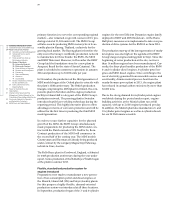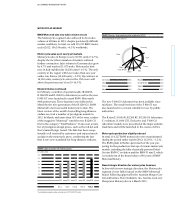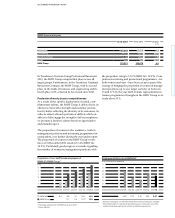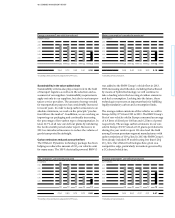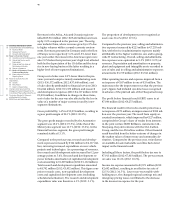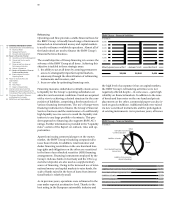BMW 2013 Annual Report Download - page 44
Download and view the complete annual report
Please find page 44 of the 2013 BMW annual report below. You can navigate through the pages in the report by either clicking on the pages listed below, or by using the keyword search tool below to find specific information within the annual report.
44
18 COMBINED MANAGEMENT REPORT
18
General Information on the BMW Group
24 Report on Economic Position
24 Overall Assessment by Management
24 General and Sector-specific
Environment
27
Financial and Non-financial
Performance Indicators
29 Review of Operations
29 Automotive Segment
35 Motorcycles Segment
36 Financial Services Segment
38 Research and Development
40 Purchasing
41 Sales and Marketing
42 Workforce
44 Sustainability
47 Results of Operations, Financial
Position and Net Assets
56 Events after the End of the
Reporting Period
63 Report on Outlook, Risks and
Opportunities
81 Internal Control System and Risk
Management System Relevant for
the
Consolidated Financial Reporting Process
82
Disclosures Relevant for Takeovers
and Explanatory Comments
85
BMW Stock and Capital Markets
Economic success, the responsible use of resources and
the assumption of our social responsibilities are the
cornerstones for long-term growth and a continual rise
in the value of the business. For this reason, due
con-
sideration to ecological and social criteria along the
entire value-added chain and a clear commitment to the
preservation of resources are values that are firmly em-
bedded in the philosophy of the BMW Group.
Again in 2013, the Group successfully maintained its
leading position among the most sustainable carmakers
worldwide – a fact borne out by the top places achieved
in prestigious ratings. The BMW share was again included
in the Dow Jones Sustainability Indices (DJSI, Europe
and World), making the BMW Group the only carmaker
to be consecutively listed in the top three for the last
15
years. In the Global 500 Rating of the Carbon Dis-
closure Project (CDP), in 2013 we achieved our best re-
sult of all time and with 100 out of 100 possible disclo-
sure points and a performance assessment in the best
‘A’ ranking, making us leaders in our sector.
More-
over, the BMW Group was again included in the British
FTSE4Good Index in 2013.
Clean production
The integration of environmental management in all
production processes enables us to minimise our use
of
resources and cushion their environmental impact.
Since 2006 we have reduced both the resources utilised
and the emissions per vehicle produced by an average
of 41.4 %.
The individual figures are as follows:
SUSTAINABILITY
Due to the increasing significance of contract production,
only vehicles manufactured at BMW production plants1
are taken into account to calculate environmental per-
formance indicators, since, looking forward, this is seen
as the best way to ensure a differentiated portrayal of
the resource efficiency of the BMW Group’s own produc-
tion
capacities.
In 2013, the utilisation of resources and the emissions
per vehicle produced were again reduced by an average
of 6.6 % compared with the previous year, thus giving
rise to savings of €6.8 million.
Despite extensive in-house production (e. g. CFRP manu-
facturing)
and the construction / commissioning of new
structures worldwide (such as the new foundry at the
Landshut plant), we managed to further reduce the
energy consumption per vehicle produced to 2.36 MWh
or 2.1 %. Improved energy efficiency, the utilisation of
highly efficient, ecologically sustainable combined heat
and power plants (CHPs) and the use of electricity
generated from renewable sources enabled us to reduce
the carbon emissions per vehicle produced by 5.6 % to
0.68 tons during the period under report.
In order to generate sufficient energy at its various pro-
duction plants, the BMW Group makes good use of its
own combined heat and power plants. The calculation
of energy efficiency within the BMW Group’s produc-
tion network has been adjusted to allow for increased
consumption caused by conversion due to the growing
use of CHP plants. The previous year’s figures have
been adjusted accordingly.
The volume of water required per vehicle produced also
fell to 2.18 m3 (– 1.8 %) in 2013. The amount of process
wastewater produced decreased by 7.8 % to 0.47 m3 per
vehicle produced. Measures implemented due to the
continual improvement process and good capacity
utili-
sation at our plants contributed towards improved
efficiency in the use of both energy and water. At the
Spartanburg plant in the USA in particular, water con-
sumption was lowered by the use of condensed water
gained from the cooling system.
The amount of non-recyclable production waste fell
significantly by 11.4 % to 5.73 kg per vehicle produced
in 2013. A strong contributing factor was the decrease
in non-recyclable waste by almost one-quarter (23.3 %)
at the Landshut plant.
Solvent emissions were reduced by an impressive 10.7 %
to 1.59 kg per vehicle produced during the period un-
der report, an achievement primarily due to the retrofit-
ting of the paint shop to include an exhaust air filtering
system at the Dadong2 plant in China.
Energy consumption – 31.0 %
Water consumption – 33.1 %
Process wastewater – 42.7 %
Non-recyclable waste – 69.7 %
Solvent emissions – 36.7 %
CO2 emissions – 35.2 %
1 Including BMW Brilliance joint venture.
2 Joint venture BMW Brilliance.


